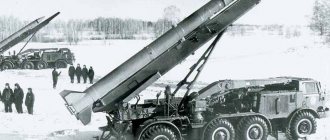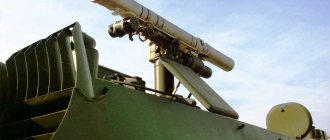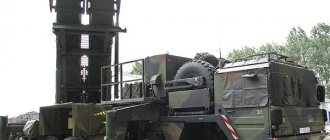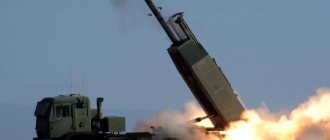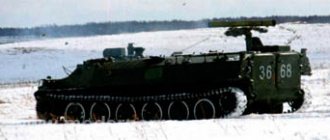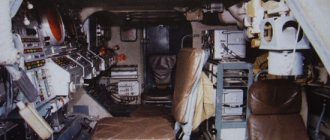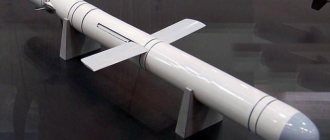The 9K720 operational-tactical missile system (according to NATO classification - SS-26Stone) appeared on paper as a concept back in the early 80s of the last century. Its creation was timed to coincide with one of the stages of the Cold War, when the superpowers decided to limit the use of nuclear weapons for military purposes. To maintain the combat effectiveness of missiles, a significant increase in accuracy was required, which the inertial control system could not provide.
Demonstration of PU at the test site
In addition, the following aspects were expected to be achieved:
- the ability to maintain control over the projectile along the entire trajectory of movement to the target or most of it;
- automate the bulk of calculation tasks, including data exchange;
- use the rocket as a carrier for various warheads (a total of 10 are currently known).
The history of the creation of the Iskander missile system
Several design bureaus and institutes took part in the development of Iskander, but the leading enterprise was the Federal State Unitary Enterprise Design Bureau of Mechanical Engineering (Kolomna). By that time, the organization had a lot of missile systems, and previously the institution was developing most of the mortar systems that entered service, both from the Soviet period and for the needs of the Russian army.
Complex "Oka"
The development of Iskander was undertaken by S.P. Invincible, a designer who had gained enormous experience in creating similar systems using the example of the Oka complex. According to experts, the predecessor of the vehicle in question was the first in history capable of passing through means of destroying an enemy threat from the air with a probability almost equal to 100%. Thanks to this property, it was meant to ensure a high percentage of hits on intended targets. However, the equipment was destroyed in accordance with an agreement between the main participants in the Cold War, concluded in 1987. But a small number of vehicles were in service with the Russian army until 2003.
The baton for the development of a unique machine was taken up by Valery Kashin, who to this day is the general designer and head of the design bureau.
The KBM received a difficult task: the missile must destroy stationary targets and those in motion. It was important to guarantee a high probability of overcoming defense systems and getting hit. A serious difference from its predecessor was the fact that the warhead should not carry a nuclear warhead. It was supposed to compensate for the weakening scale of destruction through minimal deviation from the target.
Launchers on the march
The ability to pass unnoticed anti-aircraft systems and missile defense is based on the following technical solutions:
- The surface of the case was created as smooth as possible, which made it invisible;
- Protection from radar equipment was achieved by applying a special coating;
- A unique feature was the maneuvering of the missile in flight, which made it impossible to calculate the meeting point and, therefore, to shoot it down.
Achieving ideal smoothness of the rocket was not easy, since during operation it is necessary to perform logistics operations, dock equipment, etc. All this is realized through integrated fastening elements, but at the moment of the shot all irregularities are smoothed out. To do this, several clips of two half-rings are installed, which are connected by locks that detonate upon startup and activate automatic covers. Thus, the places of detachable connections are closed when the rocket leaves the guides. Tricky, isn't it?
This set of capabilities made the rocket unique: so far no foreign development can compare with it. Experts argue that any analogues are an order of magnitude inferior to the Russian system and are unable to solve such complex problems. During the development phase, all these aspects required numerous modifications, which made the car unique in comparison with the original sketches.
Driving around the city
The product “Iskander M complex” has been developed since 1993, when the corresponding decree of the country’s president appeared. The technical specification issued by the design bureau required an integrated and innovative approach. The design used and tested all the advanced achievements of science within the country itself and abroad.
The tests that were carried out within three types deserve special attention: bench, flight and climatic. The testing ground for them was Kapustin Yar, where at one time many missile innovations of the USSR and the Russian Federation were tested. Some tests were conducted in other regions of the state.
The process was completed in 2011, when the vehicle was equipped with a missile with the 9M723 index, which performed well during testing. In addition, a new guidance system was integrated - correlation.
Column of Iskanders on the streets of the capital
The system was adopted by the Russian Army in 2006. The complexes began to enter service in the Western Military District 4 years after being put into service. The first batch of cars consisted of 6 units. The state program envisages putting 120 complexes into operation by 2022. In 2022, 7 brigades will be formed in the Russian army, which will use Iskander-M vehicles. In the same year, two vehicles will be transferred to the formations of the Eastern and Southern districts.
The purpose of the Iskander complex
According to the assignment, the reconnaissance and strike complex was supposed to hit from 20 to 40 targets in an hour, which required a large amount of ammunition. That is why it was decided to place 2 missiles on one chassis at once.
Missiles in firing position
The increased weight had to be compensated by the development of a new chassis. If for previous generations (Tochka, Oka) the base was designed by the Bryansk plant, the new four-axle chassis was developed by the Minsk plant. As a result, it was possible to place the entire complex of weapons and launch control on one base.
The main task of the complex is to defeat the targets of the following objects:
- small targets performing storage and supply functions;
- strikes against targets behind potential enemy lines;
- enemy tactical means of destruction - MLRS (multiple launch rocket systems), artillery with a long firing range, similar to the RK;
- aviation during parking and maintenance;
- strategically important objects, communication points;
- key points of civil infrastructure.
Launching a rocket
The listed tasks are solved using various warheads that can be equipped with a rocket. Most often it is a cassette with 54 damaging components, or a high-explosive fragmentation, penetrating one. At the same time, the vehicle has enormous potential, so more advanced parts are expected to appear in accordance with more complex combat missions.
The practice of modern wars shows that the weapon itself does not guarantee victory, regardless of characteristics, lethality and accuracy. If equipment is not included in a coordinated intelligence system or there is no possibility of prompt exchange of information, its effectiveness tends to zero.
Taking into account the trend, the work of the complex is carried out based on information from various sources: satellites, drones and reconnaissance aircraft. The data arrives at the preparation point, where it is converted into a calculation task that is transmitted to the division's command and staff vehicles. After this, the task is set directly for execution. The system is controlled via local networks based on Russian computers, which can be easily upgraded and replaced with more advanced ones in the future.
Composition of the Iskander missile system
Of course, without support, the installation is not able to complete the entire range of tasks, which is why the support/supply group includes many pieces of equipment.
In addition to the self-propelled missile launcher (MZKT-7930 chassis), there is:
- command and staff vehicle, for which KAMAZ became the base;
- transport-loading - on a chassis identical to the launcher itself;
- mobile information preparation point at the KAMAZ base;
- regulations and maintenance vehicle, crew life support vehicle, sets of equipment (training and arsenal), for which KAMAZ trucks became the basis.
Taken together, the equipment is capable of performing a wide range of combat missions almost autonomously, taking up positions.
Column on the march in the field
Rocket
The 9M723K1 rocket used is single-stage and runs on a solid propellant engine. The trajectory of movement is quasi-ballistic, that is, it cannot be predicted. During flight, active maneuvering is carried out, and gas-dynamic and aerodynamic rudders are used to control movement to the target.
The projectile has unique characteristics. Manufactured using various advanced techniques to reduce radar signature, in particular, “stealth technologies” are used: the body has special coatings, the dispersion surface is minimal, protruding parts are minimized in size, and in the air the rocket becomes almost perfectly smooth.
Sectional view of a rocket
The main trajectory of movement is at an altitude of 50 km, but at the peak the values can reach twice as high. At the initial and final stages of the flight, active maneuvering is carried out, when the probability of hitting the missile is greatest, and the equipment is subject to overloads of up to 20-30 units. Guidance until the final section (immediately after the salvo and at the main interval of the trajectory) is inertial, and at the final interval it is optical, that is, a combined method is used, due to which it is possible to achieve maximum accuracy with an error of 5-7 meters.
To operate the first type of guidance system, it is possible to use GPS/GLONASS. Since 2013, electronic warfare devices have been integrated into the design, which allows the projectile to be protected from air defense immediately before a target encounter.
The process is implemented by setting up two types of interference:
- active;
- passive - at the level of surveillance/firing radars, which includes the release of noise and false targets.
Self-propelled launcher
This is the main means of the group, which transports, stores and launches missiles. The product chassis received the MZKT-7930 index.
Self-propelled launcher with two missiles
The vehicle was developed specifically to perform tasks in this complex, capable of carrying a load of 19 tons, while developing 70 km/h on the highway and up to 40 over rough terrain. The combat crew includes three people. The fuel range reaches thousands of kilometers.
Transport-charging machine
On a similar basis, another vehicle of the group was created, carrying two missiles on board.
Transport-charging machine in operation
To load the main installation, a crane is used, integrated into the design and crew of two people. The total weight of the vehicle is 40 tons.
Command and staff vehicle
An important decision was the use of a command post vehicle for automated control.
Command and staff vehicle
Created on the basis of KAMAZ. The equipment is unified for each link. To coordinate actions, a chain has been formed: launch battery – missile division – missile brigade. Interaction is supported in open and closed mode, the communication range on the march is 50 km, in a stationary position - 350, transmitting a command takes no more than 15 seconds, the task is calculated in 10 seconds.
A crew of 4 people can deploy/collapse the installation in half an hour, after which it operates continuously for two days.
Regulation and maintenance machine
The abbreviation of this unit of the complex is MRTO. It is necessary to assess the performance of systems and devices, as well as on-board equipment in the field.
Regulation and maintenance machine
On board there is everything necessary for emergency repairs. Deployment by two people takes up to 20 minutes; checking missile systems does not exceed a third of an hour.
Rocket complex life support machine
In the MJO, people servicing systems and equipment can eat and sleep while on duty.
For this purpose, two compartments are equipped, including 6 berths, a 300-liter water tank, and two lockers in each block.
Performance characteristics of the Iskander missile system
The Iskander complex fully complies with the main provisions of the agreement between the countries aimed at limiting the use and sale of missile technologies.
According to the classification, theses are as follows:
- It is prohibited to sell missiles with a range of more than 300 km (the Iskander has 20 kilometers less);
- The payload should be less than 0.5 tons (domestic development is capable of carrying 480 kg).
In addition, the carriers used run on solid fuel, which means that upgrading them to increase their range is difficult.
TTX:
| Shortest distance to target, km | 50 |
| The largest varies depending on the modification of the car: under the symbol E/M/K, km | 280/500/2000 (R-500 cruise missile) |
| Maximum permissible warhead weight, kg | 480 |
| Weight of the vehicle with equipped missiles, t | 42,3 |
| rocket engine | Solid propellant rocket motor; |
| Number of missiles: | on the loading machine - 2 on the launcher itself two more |
| Calculation, persons | 3 |
| Operating temperature range, degrees | -50 — +50 |
| Operating life/including under conditions of intended use, years | 10/3 |
| Hit error, m | 5-30 |
| Projectile mass at launch, t | 3,8 |
| Height, mm | 7200 |
| Caliber, mm | 920 |
| Cruising speed, m/s | 2100 |
| Ceiling on a ballistic trajectory, km | More than 100 |
| Required time to fire a shot, min | 4-16 |
| Period before launch of the second rocket, min | 1 |
No similar weapon system can boast of such parameters, which makes the vehicle a unique means of warfare. Not only its functionality and multitasking are noted, but also the potential for deep modernization, which will extend the service life of the troops.
Set of strengths
What do we end up with? It is difficult to call the Iskander complex a superweapon. But his combined strengths and capabilities, coupled with competent command, make him an extremely difficult and dangerous target. A sudden move to a firing position, shooting from a maximum distance and a quick change of position leaves virtually no chance for the enemy to destroy the launch complex.
(Photo: Russian Ministry of Defense)
And only numerous craters there, five hundred kilometers from the launch site, will indicate that the enemy’s field headquarters was located here quite recently. That’s why you shouldn’t joke with Iskander while drinking Coca-Cola at your base. Especially if you are at least theoretically within reach. A2/AD is such a thing.
Combat characteristics of the complex
During development, the machine has great potential, thanks to the use of advanced technical solutions and achievements from the field of science. In fact, this is the latest generation of missile systems, with the potential for modernization in accordance with the realities of the future. The combat effectiveness of the vehicle makes it a leader among all existing Russian and foreign analogues. For example, some experts compare the complex with the United States fourth-generation destroyer Donald Cook.
Exercise installation
To obtain up-to-date intelligence and information on targets, it is possible to interact with various means. It is used to process information about the location, number of the enemy and other data necessary for an accurate strike. To set a combat mission, command and staff vehicles equipped with Russian computers are used, in addition, orders can come from artillery control points.
Depending on the purpose, several modifications were created. Among them, there is an export option aimed at supplying weapons abroad:
- "Iskander-M" - for the Russian army;
- Modification K uses cruise missiles;
- A complex with index E is an option for sale that fully complies with the MTCR.
Experts say that no other modern missile defense system can oppose the tandem of the M and K modifications. In the future, the vehicles will become the basis of the Russian Federation's land-based missile forces. By 2022, 120 units will be delivered to the army.
History of the development of the 9M729 SSC-X-8 Novator missile
Cruise missile 9M729 "Novator" photo
Development of the Russian 9M729 Novator cruise missile began in the 2000s. The key purpose of its creation was the need to obtain a tactical missile capable of effectively delivering precise strikes at distances of up to 500 kilometers or more, which, according to Western sources, indicates that Russia was violating the Intermediate-Range Nuclear Forces Treaty.
Photo: 9M729 Novator cruise missile
Thanks to a series of successful tests, the 9M729 SSC-X-8 Novator missile was adopted by the Russian army, but this fact led to the fact that the United States of America declared a violation of the INF Treaty by Russia, and in early February 2022 began the procedure for withdrawing from Agreement.
Combat use
There is no conclusive evidence regarding practical use, but there is some evidence that iskandar was involved in the 2008 conflict between Georgia and Ossetia. A statement about the use of the installation was made by Shota Utiashvili, who then held the post of head of the information and analytical department of the Georgian police. According to his statement, the Russian armed forces used vehicles at facilities in Poti, Gori, as well as along the Baku-Supsa oil pipeline.
The evidence includes photographs of missile debris, but only some of them have markings identical to Iskander missiles. Could this be falsification and provocation?
Don't interfere - he'll kill you, or A2/AD
It is good to fight with someone who practically cannot harm you. You can lazily launch drones if the enemy does not have high-quality air defense, carry out air raids deep into his combat formations and destroy the required targets. In response, he will only throw a spear, and you will laugh.
Russia or China are a completely different matter. Even in the event of a non-nuclear conflict, these countries have many ways to cause damage - unacceptable for those who want to fight with little, or even better, foreign blood of Americans.
Ways to do this were listed, recorded, and the range was measured.
Everything that came within the range of Russian S-300 and S-400 systems, Bastion and Bal coastal anti-ship missile systems, as well as land-based Iskanders, was declared the so-called A2/AD (anti-access and area denial ) - “prohibited access and maneuver zone.” In other words, this is a place where American troops cannot be without the danger that something very, very painful will come from somewhere.
